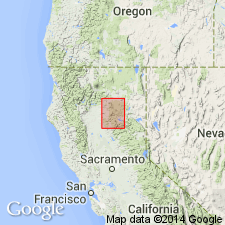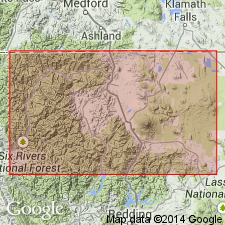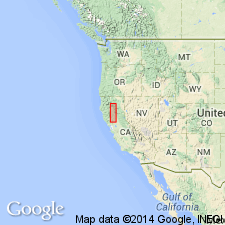
- Usage in publication:
-
- Tuscan formation*
- Modifications:
-
- Original reference
- AAPG geologic province:
-
- Klamath Mountains province
- Sacramento basin
Summary:
Tuscan formation. Composed wholly of fragmental material derived from the numerous volcanoes of Lassen Peak district. Much of it is fine, clearly stratified, and properly called tuff, but a large part is aggloemrate of coarse and fine material intermingled. Most fragments are angular, but some beds are made up of pebbles well rounded by water action. Best exposed in canyons of Mill, Deer, and other creeks on their way from the mountains to Sacramento Valley. At a number of points there are sheets of lava in the tuff. Is youngest Tertiary deposit in region. Rests on Ione formation. [The deposits mapped and described as Tuscan formation in 1892 prelimin. proof-sheet ed. of Lassen Peak folio are divided into Tuscan formation and Ione formation in the completed Lassen Peak folio.]
Source: US geologic names lexicon (USGS Bull. 896, p. 2200).

- Usage in publication:
-
- Tuscan tuff*
- Modifications:
-
- Overview
- AAPG geologic province:
-
- Klamath Mountains province
- Sacramento basin
Summary:
The Tuscan tuff ranges in thickness up to more than 1,000 feet. Age is Pliocene.
Named from exposures at or near Tuscan Springs, [northwest of Red Bluff, approx. Lat. 40 deg. 14 min. 25 sec. N., Long. 122 deg. 06 min. 41 sec. W., Tehama Co.], Lassen Peak quadrangle, northern CA. Recognized in Lassen Peak, Redding, and Chico regions, northern CA.
See also Russell and Vander Hoof (1931) entries under Nomlaki and Tehama.
Source: US geologic names lexicon (USGS Bull. 896, p. 2200).

- Usage in publication:
-
- Tuscan formation
- Modifications:
-
- Age modified
- AAPG geologic province:
-
- Klamath Mountains province
- Sacramento basin
Summary:
Pg. 375-410. Assigned Tuscan formation to late Pliocene.
Source: US geologic names lexicon (USGS Bull. 896, p. 2200).

- Usage in publication:
-
- Tuscan formation*
- Modifications:
-
- Areal extent
- AAPG geologic province:
-
- Sacramento basin
Summary:
Pg. 231-232, pl. 3. Tuscan formation consists of series of volcanic breccias, tuffs, volcanic gravels and sands, and tuffaceous clays. Maximum thickness about 1,000 feet. Greatest thickness occurs along eastern edge of formation, where only breccias are found. Thins in direction of Sacramento Valley, where gravels, sands, silts and clays are interbedded with the breccias. Contemporaneous with and interfingers with Tehama formation in their zone of junction. Nolmaki tuff member interbedded in both formations. [Age is Pliocene.]
Source: US geologic names lexicon (USGS Bull. 1200, p. 3989).
For more information, please contact Nancy Stamm, Geologic Names Committee Secretary.
Asterisk (*) indicates published by U.S. Geological Survey authors.
"No current usage" (†) implies that a name has been abandoned or has fallen into disuse. Former usage and, if known, replacement name given in parentheses ( ).
Slash (/) indicates name conflicts with nomenclatural guidelines (CSN, 1933; ACSN, 1961, 1970; NACSN, 1983, 2005, 2021). May be explained within brackets ([ ]).

